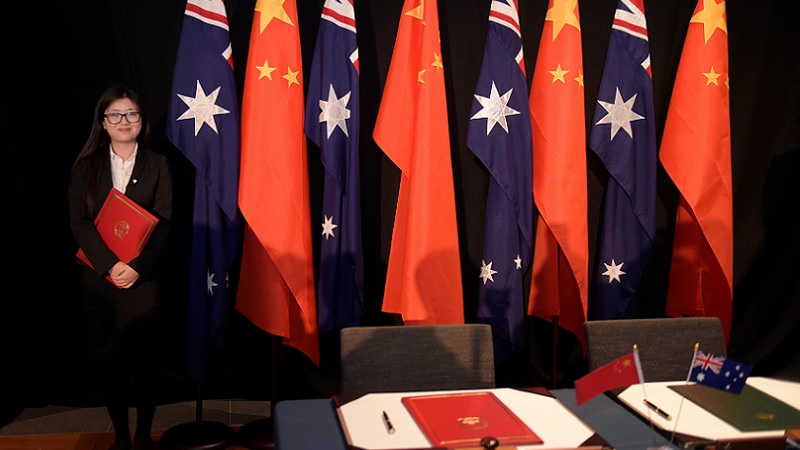The China FTA: all the facts and figures
September 22 2015

1. Critics have called for mandatory labour market testing (LMT) with respect to the China FTA. Data from the Department of Immigration and Border Protection show that nine out of 10 Chinese workers[1] temporarily entering Australia are in skill level one and two occupations.[2] There is no current legislative requirement for LMT for temporary overseas workers in skill level one and two occupations from any country.[3]
2. Australia’s FTAs with Chile, Japan, Korea, Malaysia, New Zealand, Singapore, Thailand and the U.S provide an exemption[4] from a legislative requirement for LMT for skill level three occupations[5], nursing and some engineering positions. The China FTA proposes that China joins these countries.[6]
3. In the China FTA, China is offering Australian workers concessions in many of the same categories.[7]
4. The number of skill level three workers temporarily entering Australia from China over the past nine months was 269. This is just 0.7 percent of all 457 visas granted to temporary skilled workers from overseas during the period. The proportion has been less than one percent in each of the past six years.[8]
5. Over the past nine months the number of Chinese bricklayers temporarily entering Australia was 18; electricians, fewer than five; carpenters, fewer than five; plumbers, zero.[9]
6. Australia’s FTAs with lower wage countries such as Thailand and Malaysia mean that LMT is not required with respect to skill level three workers from these countries. Yet over the past nine months the number of these workers from Thailand was just 29; from Malaysia it was 38.[10]
7. Irrespective of whether there is a legislative requirement for LMT, Australia’s existing laws mean that temporary skilled workers from overseas still need to be given pay and conditions at least as good as local workers who are doing the same work at the same workplace.[11]
8. In July Migration Council Australia said that LMT was abolished in 2001 because it was ineffective. They explained: “Malicious employers could easily sidestep such regulation while the majority of employers who acted in good faith were burdened with administration proving the job advertisement requirement”. LMT was only reintroduced in 2013 and even then for just a minority of occupations.[12] An independent review of the 457 visa scheme in 2014 recommended that LMT again be removed for the same reason it was back in 2001.[13]
9. The China FTA removes mandatory skills assessments for Chinese workers in 10 occupations, including electricians.[14] Over the past nine months the number of Chinese workers entering Australia in these occupations totaled just 15. It has been fewer than 40 in each of the last six years.[15] The FTA brings China into line with the way Australia treats 150 other countries around the world. Required skill levels do not change and all licensing and registration requirements at the federal and state level remain.[16]
10. A Memorandum of Understanding (MOU) on Investment Facilitation Arrangements (IFAs) [17] was negotiated alongside the China FTA but is separate from the agreement.[18] These potentially allow for skilled overseas workers to be brought in on Chinese-funded infrastructure projects worth more than $150 million. IFAs are assessed on a case by case basis and the Australian government retains the right to require LMT (clause 8).[19] Failing to pass the customs legislation needed to enable the China FTA will not stop IFAs.
11. Also negotiated alongside the China FTA was an MOU for “Work and Holiday” visas. Australia already offers such visas to 29 other countries.[20]
12. The China FTA does not relax restrictions on Chinese investors buying Australian residential real estate, agricultural land or agribusinesses, nor those wanting to invest in sensitive sectors such as media, telecommunications and defence-related industries. All investment from Chinese state-owned companies will continue to be screened, irrespective of value.[21]
13. In August the IMF forecast that China’s economy will be 44 percent bigger in 2020.[22] In the last year alone China has added new spending worth more than half of Australia’s GDP.[23]
14. The China FTA will see Australia cut tariffs on Chinese goods of up to 5 percent. China has committed to cutting tariffs on Australian goods of up to 30 percent.[24]
15. In 2014, China bought Australian goods and services worth $45 billion more than Australia bought Chinese goods and services.[25]
16. Over the past five years, Australia’s goods and services exports to China increased by $50.5 billion. This accounted for two-thirds of the increase in Australia’s total goods and services exports.[26]
Further Reading
James Laurenceson, "Malcolm Turnbull must push the China FTA deal through", The Australian, September 23 2015
Greg Sheridan, "Labor’s FTA worker test ‘discriminates against China’", The Australian, September 23 2015
Footnotes
[1] https://www.border.gov.au/ReportsandPublications/Documents/statistics/45...
[2] Skill level one and two occupations are mostly managers and other professionals.
[3] http://parlinfo.aph.gov.au/parlInfo/download/committees/commjnt/29036158...
[4] https://www.comlaw.gov.au/Details/F2014L01510; https://www.comlaw.gov.au/Details/F2014L01676
[5] Skill level three occupations are mostly trades-based.
[6] http://parlinfo.aph.gov.au/parlInfo/download/committees/commjnt/29036158...
[7] http://dfat.gov.au/trade/agreements/chafta/fact-sheets/Documents/fact-sh...
[8] https://www.border.gov.au/ReportsandPublications/Documents/statistics/45...
[9] https://www.border.gov.au/ReportsandPublications/Documents/statistics/45...
[10] https://www.border.gov.au/ReportsandPublications/Documents/statistics/45...
[11] http://www.border.gov.au/visas/SiteAssets/457-your-rights-work.pdf
[12] http://www.aph.gov.au/DocumentStore.ashx?id=752356d7-5d9b-43b0-ad75-ca87...
[13] http://www.border.gov.au/ReportsandPublications/Documents/reviews-and-in...
[14] http://dfat.gov.au/trade/agreements/chafta/official-documents/Documents/...
[15] https://www.border.gov.au/ReportsandPublications/Documents/statistics/45...
[16] http://dfat.gov.au/trade/agreements/chafta/fact-sheets/Pages/chafta-myth...
[17] http://dfat.gov.au/trade/agreements/chafta/official-documents/Documents/...
[18] http://dfat.gov.au/trade/agreements/chafta/official-documents/Documents/...
[19] http://dfat.gov.au/trade/agreements/chafta/official-documents/Documents/...
[20] http://www.australia.com/en/planning/working-holiday-visa.html
[21] http://dfat.gov.au/trade/agreements/chafta/fact-sheets/Pages/key-outcome...
[22] https://www.imf.org/external/pubs/ft/scr/2015/cr15234.pdf
[23] http://data.worldbank.org/indicator/NY.GDP.MKTP.CN; http://www.rba.gov.au/statistics/tables/xls-hist/f11hist.xls
[24] http://dfat.gov.au/trade/agreements/chafta/fact-sheets/Pages/key-outcome...
[25] http://dfat.gov.au/trade/resources/trade-statistics/Documents/australias...
[26] http://dfat.gov.au/trade/resources/trade-statistics/Documents/australias...
